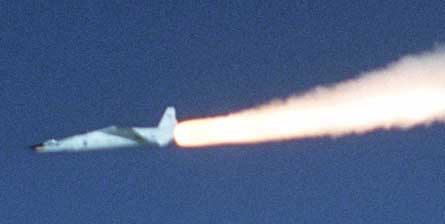By Graham Warwick in Washington DC
Ground testing of a hydrocarbon-fuelled scramjet engine has been completed, paving the way for the next step towards flight testing of a hypersonic missile demonstrator late in 2008. The Pratt & Whitney Rocketdyne GDE-2 ground demonstrator engine was tested at Mach 5 in NASA Langley’s High Temperature Tunnel.
The GDE-2 was tested to gather data for the P&W SJX61-1 scramjet that will power the US Air Force Research Laboratory’s X-51A hypersonic missile technology demonstrator, says Bob Mercier, deputy for technology at AFRL’s aeropropulsion directorate.
|
|---|
| In 2004 NASA's hydrogen-fuelled X-43A hit Mach 9.6 |
The Langley tests marked the first time a hydrocarbon-fuelled, fuel-cooled scramjet with full-authority digital engine control had been tested at hypersonic conditions. “GDE-2 is a flight-weight engine with closed-loop fuel control,” says Mercier. “It’s a little different in size, and has a different inlet, but has provided data on fuel control for the X-51.” This includes the transition from ethylene to JP7 jet fuel.
“We start with ethylene, which is more reactive, then change to JP7 when the engine is warmed up.” NASA’s X-43A hypersonic testbed, which reached M9.6 in 2004, was hydrogen fuelled.
The SJX61 scramjet is planned to be ground tested at Langley in the fourth quarter, first at M4.5-5 and then at M6.5. Compared with the GDE-2, this engine has a fixed-geometry, reverse-swept inlet that is designed to start easily and operate over a range of speeds, says Mercier, adding: “This will be the first scramjet to accelerate over a range of Mach numbers.”
Source: Flight International














